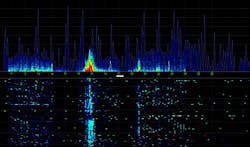Latest contract brings to four the number of contractors for DARPA RF spectrum sharing
ARLINGTON, Va., 16 Oct. 2013. Radio researchers at Michigan Technological University (Michigan Tech) in Houghton, Mich., are joining a U.S. military research program to develop technology for RF spectrum sharing among radar and radio communications systems to improve capability and avoid cross-platform interference.
Officials of the U.S. Defense Advanced Research Projects Agency (DARPA) in Arlington, Va., have awarded a $681,050 to Michigan Tech for the Shared Spectrum Access for Radar and Communications (SSPARC) program.
Michigan Tech joins SAZE Technologies LLC in Silver Spring, Md., the Lockheed Martin Corp. Advanced Technology Laboratories in Cherry Hill, N.J., and Science Applications International Corp. (SAIC) in McLean, Va., on the DARPA SSPARC program, which seeks to develop technology applicable to spectrum sharing among military radars and military communications systems, as well as among military radars and commercial communications systems.
DARPA has awarded a $747,471 contract to SAZE Technologies, a $2.6 million contract to Lockheed Martin, and a $2.1 million contract to SAIC for the SSPARC program, which will focus on spectrum sharing systems and separation mechanisms, supporting technologies that improve performance when sharing spectrum, theoretical performance limits and grounded design techniques, and relevant regulatory topics, DARPA officials say.
Spectrum congestion is a growing problem, DARPA experts say. It increasingly limits operational capabilities due to the increasing deployment and bandwidth of wireless communications, the use of network-centric and unmanned systems, and the need for increased flexibility in radar and communications spectrum to improve performance and to overcome sophisticated countermeasures.
Radar and communications together consume most of the desirable spectrum below 6 GHz, and the SSPARC program will try to develop sharing technology that enables sufficient spectrum access within this desirable range for radar and communications systems.
The SSPARC program seeks to support two types of spectrum sharing. First, it seeks to share spectrum among military radars and military communications systems and both capabilities simultaneously when operating in congested and contested spectral environments.
The program seeks to share spectrum among military radars and commercial communications systems by preserving radar capability while meeting national and international needs for increased commercial communications without the high cost of relocating radars to new frequency bands.
In cooperative spectrum sharing, radar and communications systems share information in near real time, which enables the systems not to interfere with each other based on how they actually use the spectrum, not on how they might use it, DARPA researchers say.
Researchers from Michigan Tech will focus on combining a distributed spectrum resource manager application and employing a machine learning control layer with three spectrum sharing techniques that support the transition, DARPA officials say.
A valuable aspect of the project is a strong code-in-the-loop simulation approach leveraging validated models of the radar and military radio transition targets.
Researchers from SAZE Technologies, meanwhile, will combine radar and communications where a base station plays both functions simultaneously, DARPA officials say. Company experts will co-design multiple-input and multiple-output (MIMO) communications and MIMO radar into one network.
Lockheed Martin will combine an extensible cognitive control plane with several system-level and device-level spectrum separation techniques. The company will demonstrate scalability through separating global control from several local control systems, with the battlespace partitioned intelligently via RF propagation analysis and geospatial reasoning; develop and characterize spectrum-sharing techniques by capitalizing on closed-loop information sharing between the radar and communications systems; and manage the cognitive control system by a spectrum sharing priority dial, which battlefield commanders can use to rebalance resources as needed.
SAIC, will combine a distributed spectrum resource manager by employing a machine learning control layer with three spectrum sharing techniques chosen to support the transition. SAIC engineers will develop a strong code-in-the-loop simulation approach by capitalizing on validated models of radar and military radio transition targets, DARPA officials say.
For more information contact Michigan Tech online at www.mtu.edu, SAZE Technologies at http://sazetech.com, Lockheed Martin Advanced Technology Laboratories at www.atl.lmco.com, SAIC at www.saic.com, or DARPA at www.darpa.mil.

